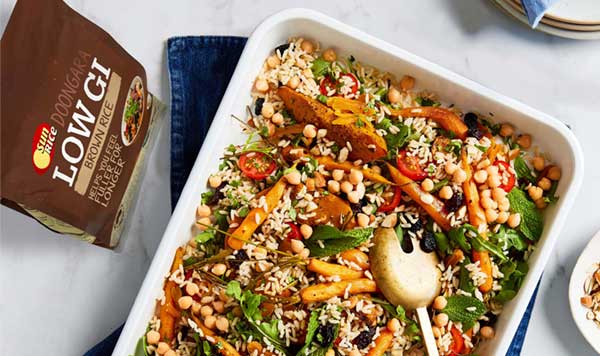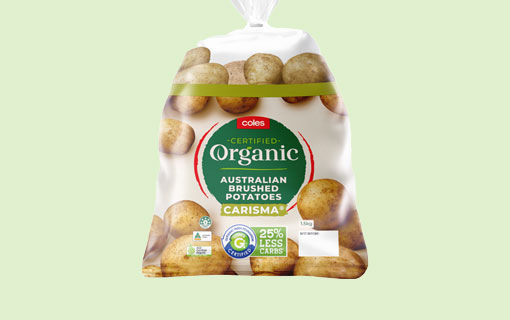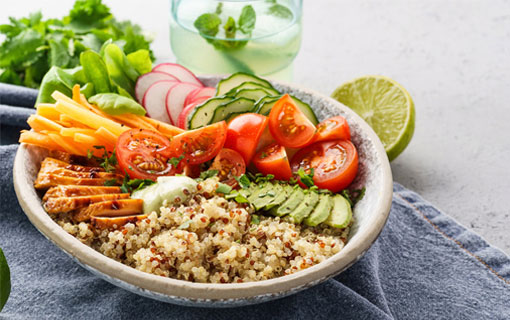Frequently Asked Questions
All your questions about low GI answered.
GI Facts
What is the glycemic index?
The glycemic index (Gi) is a relative ranking of carbohydrate in foods according to how they affect blood glucose levels. Foods with a low GI (GI ≤ 55) release glucose into the bloodstream at a slow sustainable rate.
Why is the GI important?
The scientific evidence supporting the health benefits of a healthy low GI diet is overwhelming. In Australia, two out of three men, one in two women, and one in four children are overweight or obese. Lowering the GI of your diet will help prevent and manage overweight and obesity, which are the major underlying causes of type 2 diabetes, heart disease and some cancers. For people who have diabetes, low GI diets have been proven to improve blood glucose management and to reduce the risk of complications.
What are carbohydrates and why are they important?
Carbohydrates are one of the most important sources of energy for our bodies and are mainly found in plants (fruits, vegetables, grains & legumes) or in foods made from plant sources. Carbohydrates take two forms namely starches (such as potatoes, cereals, bread, and pasta) and sugars such as table sugar (sucrose), milk sugar (lactose), and fruit sugar (fructose). All carbohydrates are eventually broken down by the body into glucose, which is:
- a universal fuel for most organs and tissues in our bodies
- the only fuel source for our brain, red blood cells and a growing foetus, and
- the main source of energy for our muscles during strenuous exercise
Is a low carbohydrate diet the same as a low GI diet?
Low carbohydrates and low GI are not the same. People often confuse a low carbohydrate diet with a low GI diet, however ‘lower carbohydrate’ does not mean ‘lower GI’. For optimum health, the evidence clearly indicates that lower GI foods and diets are not just good for glycemic control, but also linked to reduced risk of chronic disease. By contrast, low carbohydrate diets have little to offer – they may actually increase the risk of chronic disease. In practice, they are difficult to sustain over the long term because carbohydrates are part and parcel of our Western diet. In fact, there is strong evidence to suggest that moderate-carbohydrate low GI diets are better for your health and easier to sustain. The long term health effects of a low carbohydrate diet are unknown.
Low GI “diets” are more about the quality of the carbohydrate rather than the quantity. The GI is a measure of how quickly or slowly the carbohydrates in foods are broken down and absorbed into the blood stream and converted to glucose. Food labels that include both ‘lower carbohydrate’ and ‘lower GI’ may be confusing for the consumer. The Foundation’s mission is to promote the health benefits of Glycemic Index. Food labelling is a critical path to market in providing clearer and informative guidance to people seeking and selecting better quality carbohydrate foods. The Foundation therefore supports clearer labelling of lower GI rather than lower carbohydrate foods in the marketplace. Slow carb, not low carb.
POSITION STATEMENT by Jennie Brand-Miler AM, FAIFST, FNSA
Professor of Human Nutrition
The University of Sydney, Charles Perkins Centre Research and Education Hub
Director, Sydney University Glycemic Index Research Service
Director, Glycemic Index Foundation.
How will a low GI diet help me to lose weight?
A healthy low GI diet will help you to lose body fat by:
- Overcoming hunger – since low GI foods take longer to digest, they make you feel satisfied for longer and trigger natural appetite suppressors
- Fat burning – reducing insulin levels over the course of the day which makes fat easier to burn and less likely to be stored
- Maintaining your metabolic rate – a low GI diet does not result in the same steep fall in metabolic rate which is the body’s natural response to the large drop in food intake required by most quick-fix diets. You need to keep your engine revs high to lose weight and keep it off
What is the difference between glycemic index (Gi) and glycemic load (GL)?
GI Research
Why do we need to worry about our blood glucose/ insulin levels?
When digested, the starches and sugars in carbohydrates are broken down into millions of glucose molecules which are released into the bloodstream. When blood glucose levels rise, your body releases a hormone called insulin, which allows glucose to enter cells where it can be used to provide fuel for our brains, muscles and other vital organs. Insulin also plays a key role in fat storage: when insulin levels rise, our cells are forced to burn glucose rather than fat. Unfortunately most of the carbohydrates we eat tend to be highly processed and high GI. They break down quickly during digestion and cause blood glucose to rise fast and high for a short time. It’s like a roller-coaster ride on your insides – you spike then crash. Low GI carbohydrates – those that are slowly digested and absorbed – cause a much lower and slower rise in blood glucose and, therefore, insulin levels. This will help sustain energy levels longer, improving mental and physical performance and helping weight loss and the risk of developing lifestyle related diseases.
What are the different types of sugars?
The simplest form of a carbohydrate is a single-sugar molecule (glucose, fructose or galactose). Glucose is the most common form of sugar and is a major source of fuel for the cells in the human body.
- Sucrose is also known as common table sugar and is made up of glucose and fructose
- Lactose is the sugar found in milk and is made up of glucose and galactose
- Fructose is the sugar found in fruit
There are many others too – for example, dextrin, maltose and maltodextrins! All sugars are not the same. Many foods naturally high in sugars are very nutritious like fruit, milk and yoghurt. Unfortunately food labels don’t help you distinguish between the slowly absorbed and the rapidly absorbed sugars or tell you whether the sugars are naturally occurring or added.
What are starches?
Starches are long chains of the sugar glucose joined together. Starches are generally not sweet tasting. There are two types of starch in food – amylose and amylopectin. The ratio of the two starches has an effect on the GI value in some foods.
What are refined starches and why are they not good for your health?
When choosing foods for a healthy diet, you should avoid foods containing highly refined starches (e.g. white bread) as well as highly refined sugars (e.g. table sugar).
Should I be avoiding sugars in food?
Is a low GI diet just another fad/popular diet?
Popular diets that help people lose weight in the short term by cutting out a food group or nutrient (for example, no carbohydrates or no sugar or no fruit) are generally not sustainable in the long run, and are often nutritionally imbalanced, and consequently they are not recommended by health experts around the globe.
A low GI diet is not a popular diet but a way of eating that is sustainable in the long term and is backed by over 30 years of scientific evidence showcasing the benefits (see below) of adopting a low GI ‘diet’.
GI Food Index
I have heard that all sugars are high GI and all starches are low GI, is this true?
How is the GI of a food tested?
The team at the Sydney University GI Research Service (SUGiRS) describe on their website how the GI of a food is measured: www.glycemicindex.com/about
What are the benefits of a low GI diet?
A low GI diet is a simple and effective way to:
- Reduce the risk of:
- developing type 2 diabetes
- diabetes complications
- heart disease
- Improve physical and mental performance
- Reduce the risk of breast cancer
- Improve pregnancy outcomes
Making low GI choices is not a dramatic change. It simply means swapping at least one high GI food for a low GI food at every meal.
Should I avoid all high GI foods?
No. Some high GI foods, like most potatoes and brown rice, are still nutritious. Simply eat them in smaller quantities, combined with a lower GI carbohydrate. High GI foods are also useful during prolonged physical activity or when treating hypoglycaemia in people with diabetes. We recommend that you aim for at least one low GI food per meal.
How relevant is the GI for athletes?
GI can be a useful tool to help athletes select the right type of carbohydrates (the main source of fuel for the body) to consume both before and after exercise. Eating low GI foods for slow energy release is particularly important for endurance sports. On our GI & Sustained Energy page, we explain when to incorporate low GI foods and when to consume high GI foods to maximise your performance and aid recovery.
The GI Symbol
What determines whether a food is high or low GI?
Many factors can influence the GI value of a food including the physical state of a food (i.e., how it’s been processed), its fat content, acidity, the type of sugar, type of starch and particle size. Highly processed carbohydrate foods (‘convenience’ foods) tend to have high GI values because processing makes the sugars or starches more easily digestible and consequently they are quickly absorbed into the bloodstream. For example, finely milled white flour breads have a high GI compared to traditional wholegrain breads. A simple way to tell if a food is low GI is to look for the GI Symbol on the supermarket shelves or do a search on our website for those products that carry the Symbol. Scientists have tested the GI value of these products to ensure they are low GI. You will find a comprehensive list of foods tested using real people and real food on the products page.
How do I go about following a low GI diet?
Eating a low GI diet is easy. Simply swap at least one high GI food for a low GI food at each meal. The crux of it is to be smart with your carbohydrate choices. Replace highly refined carbohydrates such as white bread, sugary treats and crispy puffed cereals with less processed carbohydrates such as grainy bread, pasta, legumes, fruit and vegetables. You don’t need to cut out any foods or food groups. Click here for some swap ideas or download our low GI Shopping List.
How can I tell which foods are low GI?
What is the GI symbol?
The GI Symbol program was launched in Australia in 2002 to help consumers identify the GI of foods. Foods that carry the symbol are guaranteed to have been properly tested by an accredited laboratory and are an overall healthier choice in that category. The GI Symbol is a powerful tool for quickly and reliably making healthier food choices when grocery shopping. It’s your guarantee that the GI value stated near the nutrition information label is accurate and that the food meets strict nutritional criteria.
Who is behind the GI Symbol?
The GI Symbol program is run by the Glycemic Index Foundation, a not-for-profit health promotion charity by The University of Sydney and Diabetes NSW & ACT. It is recognised internationally as a leader in translating the science of GI into practice for consumers. The University of Sydney is one of the leading centers’ for Glycemic Index research in the world. Diabetes NSW & ACT works proactively to improve the day-to-day lives of people living with diabetes. They aim to make things easier by educating carers, employers and the general public. Their mission is a life without the complication(s) of diabetes.
Why don’t all foods that claim to be low GI have the GI Symbol?
There are several possible reasons:
- The manufacturer may have obtained a GI value from a published source (internet or published article), but not tested the food itself directly; or
- The manufacturer may have tested the food itself, using an unstated methodology; or
- They may have had the food tested following the standardised international method and make a low GI claim in the advertising and packaging but don’t meet the strict nutritional criteria or have chosen not to take part in the program
However, if a food makes a low GI claim but does not carry the GI symbol, be very cautious. A recent Australian survey found that many low GI claims are either false or inaccurate, and even when this is not the case, they are often made on products that are not ideal nutritionally (i.e. they contain too many kilojoules, saturated fat and/or salt) so don’t meet the stringent requirements of the GI Symbol program. Where a low GI claim is made on a food which doesn’t carry the low GI Symbol we encourage you to ring the manufacturer to ask if the food has been GI tested and where. If the food has been tested in Australia you should find the tested GI value on the Sydney University GI Research Service website www.glycemicindex.com.
Recommended for you

RECIPES

GI CERTIFIED PRODUCTS
DIABETES

LOW GI LIVING


A low GI diet focuses on the quality of carbohydrates you eat. Good carbohydrates (or low GI carbohydrates) are more slowly digested helping keep your blood sugars stable, whereas bad carbohydrates cause your blood glucose levels to peak and crash. Want to know which carbohydrates are best for you? Try our swap it tool!


